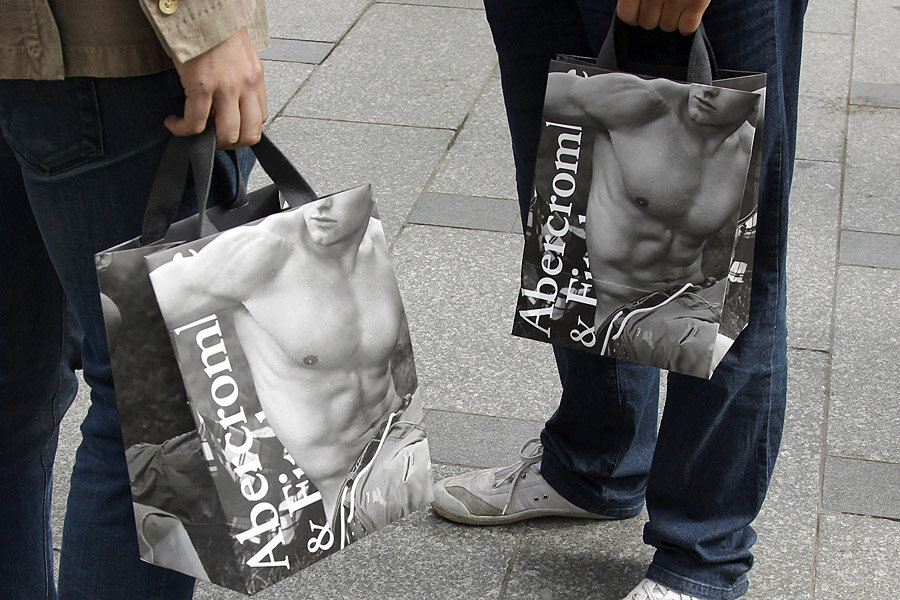Abercrombie & Fitch sheds once-prized logo from clothing
Loading...
| New York
The Abercrombie & Fitch logo has lost the power it once wielded.
Shares of Abercrombie & Fitch Co. tumbled Thursday after reporting weak sales as more teens shop elsewhere.
The company is trying to stock trendier clothing — and it turns out that means stripping off the once-prized Abercrombie logo.
It is a major change for the retailer, whose sweatshirts and T-shirts emblazoned with its name long held major cachet with teenagers. Now, individuality is the name of the game.
"Personal style, specifically with teens, is becoming less about fitting in and more about standing out," said Lauren Wolfenden, a senior advisory analyst at WGSN, a fashion trend consultancy. "A&F has wised up to this by phasing out the cookie-cutter logo-ed product look and bringing in trendy pieces that can be worn in a multitude of different ways."
A&F and other traditional teen stores have to adapt in an uphill battle to turn their businesses around as mall traffic drops and shoppers' tastes change.
A slowly recovering economy is making parents and teens to think twice about splurging on clothes. Expensive standbys like Abercrombie also have lost business to "fast fashion" chains like H&M, known for quickly churning out trendy $9 tops.
Teens are also spending less time at the mall and more time researching and buying on mobile devices. And when they do buy, they're more likely buying the latest gadget than filling their closets.
Last week, Aeropostale last week reported its seventh consecutive quarterly loss on slumping sales. It also forecast another loss in the current quarter.
At the same time, Aeropostale, based in New York, reinstated Julian Geiger, its former CEO.
Earnings at another competitor, American Eagle, have also declined on weak sales.
Mike Jeffries, A&F's CEO, said in a statement that the retailer has made progress in stocking trendier clothing and said the improvement is "clearly evident" in its back-to-school business.
"In a continuing challenging environment, our sales for the second quarter were somewhat below plan, but we have seen modest improvement since the back-to-school floor set," he added.
A&F has been shortening the time from developing a design to shipping the clothing to the stores. It's also changing its color palette.
WGSN's Wolfenden said Abercrombie announced earlier this year that it would start using black in their collections, something it had never done before. She praised some of the current fashions in the stores, which include Aztec printed silky pants, sleek maxi-dresses and slouchy T-shirts with scenic images and French sayings.
But the big change, of course, shoppers are seeing is clothes that don't shout the Abercrombie name.
For the fall shopping season, A&F has reduced its logoed merchandise by half, and plans to go further.
"In the spring season, we are looking to take the North American logo business to practically nothing," Mark Jeffries, CEO of A&F told investors on a conference call
In a note to investors Thursday, Richard Jaffe, an analyst at Stifel Nicolaus, noted that "it's taking time to win back customers." But he believes that the merchandise changes are "gaining traction."
A&F said it earned $12.9 million, or 17 cents in its fiscal second quarter. That compares with $11.3 million, or 14 cents per share, a year earlier.
Earnings, adjusted for non-recurring costs, came to 19 cents per share. Analysts surveyed by Zacks Investment Research expected 10 cents per share.
The New Albany, Ohio-based retailer reported that revenue fell 5.8 percent to $890.6 million, short of analyst estimates.
Revenue at stores open at least a year dropped a steep 11 percent, including 8 percent at U.S. stores.
A&F's shares fell nearly 6 percent, or $2.57 to $41.43 in late morning trading. American Eagle's shares fell nearly 2 percent, or 25 cents, to $13.95. And Aeropostale's shares slipped more than 2 percent, or 9 cents, to $4.07 in late morning trading.







